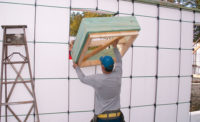Straight Green
Embodied Energy of Building Materials

During a recent ANSI Green Globes conference call, a fellow committee member suggested that embodied energy of building materials deserves greater attention in green building rating systems, now that buildings are becoming more energy-efficient. A Green Building Advisor article “All About Embodied Energy” by Martin Holladay was offered in support of this idea. Holladay begins the article by explaining that, until recently, embodied energy of building materials wasn’t worth considering because the amount of energy used in making building materials was dwarfed by the energy used to operate a building over its lifetime (between 90 to 95 percent according to a paper by I. Sartori and A.G. Hestnes “Energy Use In The Life Cycle Of Conventional and Low-Energy Buildings.”) Holladay wonders whether or not this 20-year-old rule of thumb applies today.
Calculating a Building’s Materials-to-Operations Energy Ratio
It’s simple to calculate the relationship between a buildings operational energy and the energy that was used to make its materials. You just need to know how much energy the building uses each year, how long the building will be around, and how much energy was used to make all of the materials that went into the building—including materials that need to be replaced over the life of the building. Holladay provides multiple examples of folks that have attempted the calculation for all kinds of building types of all ages all over the world, arriving at an overall value of building materials energy to operational energy anywhere from 2 to 75 percent. Why the huge spread between these numbers? Lots of reasons, on both sides of the equation. On the materials side, it is very difficult to obtain accurate, trustworthy embodied energy values. Tracy Mumma, in her article “Reducing the Embodied Energy of Buildings,” explains:
“The quantification of embodied energy for any particular material is an inexact science, requiring a long look at the entire manufacturing and utilization process, and filled with a large number of potentially significant variables. Consequently, the complexity of embodied energy calculations is frustrating even for scientists, and it is easy for the individual homeowner, builder, designer or government specifier to become discouraged at the difficulty of obtaining accurate figures.”
On the operational energy side, energy use in buildings varies widely by building type, climate/location, size, occupancy and age. In addition to these variables, an assumption must be made about how long the building will last, and often estimated anywhere from 40 to 100 years. In the article “Comparing Commercial Building Energy Use Around the World” by Hinge, Bertdoldi, and Waide, the authors compared energy use in buildings in different parts of the world and found a wide variation. They conclude that “achieving efficiency increases in the commercial sector will be impeded by its complicated mix of building sizes and uses, the complicated systems often used in commercial buildings, and the relative lack of understanding of operations factors impacting energy use and how to achieve efficiency.”
Skip the Math?
Holladay admits that there are so many uncertainties in embodied energy calculations that designers can be forgiven for throwing up their hands in defeat. But he’s not giving up on the idea just yet. Instead, he proposes that designers use a set of “general guidelines” to select building materials and components that are, evidently, simply understood to be lower in embodied energy. He offers the following:
- Choose recycled content materials over those made with virgin feedstock.
- Choose wood over concrete and steel.
- Use as much cellulose insulation as you want to.
- Don’t use too much foam plastic insulation.
While Holladay’s rules-of-thumb might result in “greener” buildings, I am not convinced that the impact in following them would be significant for any building. The available scientific data simply does not support this position. Building scientist John Straube, in his 2009 article “Why Energy Matters,” agrees:
“Scientific life-cycle energy analyses have repeatedly found that the energy used in the operation and maintenance of buildings dwarf the so-called ‘embodied’ energy of the materials. Designing buildings that consume little operational energy is not a normal skill-set: It requires much more quantitative understanding of heat transfer and radiation physics, weather and sun, and mechanical equipment operational details than architects normally possess. The operational energy use of buildings is their biggest environmental impact. Green buildings, which must be low-energy buildings, need to be designed to respond to this reality.”
Conclusion
An often duplicated graph from a 1996 Cole and Kernan paper “Life-cycle Energy Use in Buildings” clearly shows the relationship between building materials embodied energy and a building’s operational energy. The graph shows results for components of energy use during the 50-year life cycle of a typical office building with underground parking, averaged over wood, steel and concrete structures in Vancouver and Toronto, Canada.
The argument for more focus on embodied energy of materials is based on the assumption that our buildings have become much more energy-efficient but as Straube points out in his article: “The trend in the last decades has not been encouraging. According to the Department of Energy’s Commercial 2003 Building Energy Consumption Survey, the energy consumption is not less than buildings built before 2003.”
Studying the graph, it is easy to see that even if buildings energy efficiency were doubled, or even tripled, embodied energy of materials is still dwarfed by the operational energy over the life of the building.
Looking for a reprint of this article?
From high-res PDFs to custom plaques, order your copy today!






